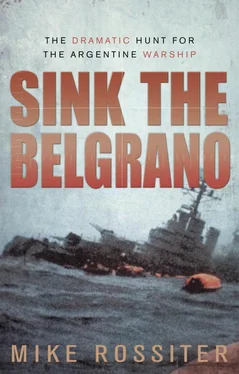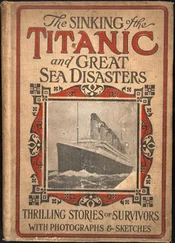When David picked up the telephone and heard the Faslane duty officer tell him that HMS Conqueror was ordered to carry out an exercise known as ‘Store for War’, his immediate reply was to tell him ‘to go and do something very painful. I had a large amount of nuclear maintenance to get through, and had no time for stupid and pointless exercises. And I made it very plain they could go and find another boat.’
The duty officer on the other end of the line persisted, however, and thirty minutes later came on board Conqueror to make sure that Commander Hall had got the message. The orders were not an exercise; they came from Admiral Sir John Fieldhouse, Commander-in-Chief Fleet, the most senior seagoing admiral in the navy. Conqueror was being scrambled for an operational emergency. David’s immediate thought was that there was a crisis in the North Atlantic, that a Russian nuclear submarine had penetrated NATO’s defences and that Conqueror was being sent to hunt it down.
HMS Conqueror was a nuclear submarine, termed an SSN, which stands for Ship Submersible Nuclear. She was not armed with missiles carrying nuclear warheads, like the SSBNs or ‘Bombers’ that hid quietly in the depths, ready to launch nuclear retaliation against the Soviet Union. The only nuclear element of Conqueror was the nuclear reactor that produced heat, which in turn generated steam to drive her turbines and propeller. Conqueror ’s job was to locate and trail warships and submarines, and in the event of war to sink them, hence the description ‘hunter-killer’.
At rest on the surface, tied up at the quayside, or ‘against the wall’ as it is known, Conqueror ’s matt black conning tower rose 30 feet above her curved deck but, like an iceberg, the vast bulk of her hull, 265 feet long and 30 feet in diameter, still lay hidden below the waterline. Almost level with the forward deck, really a narrow walkway about 6 feet in width, and about a quarter of her length back from the bow were two hydroplanes that projected outwards like short, stubby wings on either side. Further aft, all that could be seen of her stern was another black fin sticking free of the water, which was the visible part of the cruciform tail, with, below the waterline, its vertical rudder, and another two horizontal hydroplanes, and one large propeller that drove her through the water at speeds of nearly 30 miles an hour. Conqueror had no sharp bow to cut through the waves like a destroyer, or even like an older submarine such as a Second World War U-boat. Her bow slid down in a curve and disappeared into the sea, concealing the sonar receivers mounted on the bow and sides, and her six forward-pointing torpedo tubes. Even resting on the surface, about 85 per cent of the bulk of a nuclear submarine remains hidden below the sea. Once launched, submarines make only a grudging acknowledgement of life above the waves.
HMS Conqueror was the most modern expression of a type of warship that had existed throughout the twentieth century and had always carried with it an air of illegitimacy. Submariners were seen as a nasty, piratical bunch, the very nature of the craft they sailed in being unseen and underhand, preying on honest, defenceless merchant shipping. They had proved to be a very effective weapon in the First World War, as the U-boats of the German navy wreaked havoc on Britain’s seaborne trade, their reputation confirmed by their success in sinking unsuspecting passenger and merchant ships. When a U-boat torpedoed the liner Lusitania it was seen as a callous and unnecessary act, and damaged Germany’s relations with the then neutral United States. Germany’s submarine fleet was more than just a successful commerce raider, however. The threat the submarines posed to surface warships weighed heavily on the British Admiralty and their lurking presence in the North Sea kept the Royal Navy’s home fleet in port in the first two years of the war. Admiral ‘Jackie’ Fisher, the great modernizer of the Royal Navy and creator of the huge, heavily gunned and armoured dreadnoughts, prophesied that submarines would revolutionize war at sea, and the fear that U-boats instilled in British admirals seemed to bear him out.
Gradually, naval engineers started to work out ways to counter the threat that submarines posed and the balance of advantage shifted to surface warships again. Battleships were built with armour plating along their sides and large bulges on the waterline that would lessen the damage caused by exploding torpedo warheads. The science of sound detection developed, and Asdic, as the British called it, or sonar as it was known elsewhere, proved to be capable of locating submerged submarines. Once detected, they were not fast enough to outrun a warship such as a destroyer or frigate, which could carpet an area of sea with high-explosive depth-charges.
Submarines also had another, fatal weakness. They had constantly to come to the surface, either to replenish the air supply for the crew or to travel on the surface under diesel power to recharge the huge banks of batteries that powered them under water, and consequently both sonar detection and airborne radar greatly reduced their threat. During the Second World War the German navy developed the snorkel mast, which sucked in air and vented the exhaust gases so that submarines could run their diesel engines while submerged at periscope depth. However, airborne radar was quickly improved to detect the snorkel sticking up above the waves. By 1945, when the war came to an end, almost half the German submarines sunk by the Allies had been detected by aircraft when they were running on the surface or submerged at periscope depth; the other half had been sunk by warships at very close range using depth-charges.
In the last years of the Second World War the German navy carried out a lot of work in an attempt to remedy the growing vulnerability of their U-boats. It was clear that they needed to be able to achieve greater underwater speeds and to be less dependent on oxygen from the atmosphere. A system utilizing hydrogen peroxide as a fuel had been developed in the 1930s. Hydrogen peroxide broke down to provide oxygen and heat, and prototypes were developed that were designed to achieve speeds of 25 knots when submerged – enough to outrun a surface vessel in rough seas. These U-boats were still in the construction stage by the end of the war in Europe, and never saw service. There were a lot of problems with hydrogen peroxide as a fuel, despite the seeming advantages it might offer. It was a difficult chemical to store and transport, and it was extremely volatile and explosive when it came into contact with seawater. The Royal Navy took a lot of interest in this captured German technology after the war, and built a submarine called HMS Explorer that was powered by hydrogen peroxide. It was nicknamed HMS Exploder .
The Second World War had seen another development, however: nuclear energy, a product of atomic physics. Its devastating nature as a weapon was revealed in the bombs dropped on the Japanese cities of Hiroshima and Nagasaki, but it had a more promising aspect when it was utilized in a reactor, where the energy from disintegrating atoms was more controlled.
It was quickly apparent that here was a source of energy that needed no air for combustion, and was almost unlimited. Its potential was seized upon by US Admiral Hyman G. Rickover, who quickly organized a massive development project to produce a reactor that could be put into warships and submarines. The efforts resulted in the first nuclear-powered submarine being launched in 1955 – Nautilus , named after the mysteriously powered submarine in Jules Verne’s science-fiction novel Twenty Thousand Leagues Under the Sea . The modern Nautilus quickly demonstrated its unique capabilities, as impressive as anything that Verne imagined. Voyaging right around the world without coming to the surface, making dangerous journeys under the Arctic ice cap to the North Pole, the nuclear-powered submarine was as revolutionary a warship as Admiral Fisher’s Dreadnought had been forty-nine years previously.
Читать дальше












